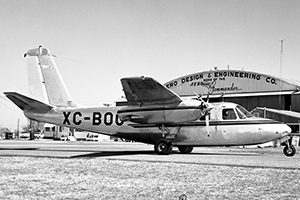By Barry Collman
First published in Flight Levels Online, Spring 2013 issue

The Model 560A was the third Commander twin to be placed into production, all by the Aero Design & Engineering Company at Tulakes Airport (later renamed Wiley Post) in Bethany, Oklahoma, near Oklahoma City.
On the face of it, 100 560As were built between July 1955 and December 1956, with serial numbers in the range 231 through 450. However, 15 of these had an optional engine and were given the factory designation 560A(HC), where the HC represented High Compression.
Of the 85 examples built of the basic 560A, 54 initially were certified in 1955, and 31 in 1956.
Of the 15 560A(HC)s built, 14 were certified in 1956 but the last one, serial number 450, did not receive its Certificate of Airworthiness until much later, in February 1957.
Later, two Model 560As were converted to Model 680s. Factory Service Change No. 35 offered all distributors a kit to effect such conversions. Another one was converted to a 680E; four to 560Es; and 14 to 560A(HC)s in addition to the 15 delivered as such.
A factory document describes the Model 560A, under Wing Drawing 5170023, as “certified to CAR 3 Amendment 12 on July 1, 1955. This Model is like the Model 560 except for the following: a) engine changed to Lycoming GO-480-C1B6 with dry sump and side-mounted accessories; b) nacelles were redesigned; c) fuselage was lengthened; d) takeoff power was increased; and e) structural changes to the wing, and new landing gear. In 1956 the engines were changed to Lycoming GO-480-G1B6.”
Type Certificate Data Sheet 6A1 says “Same as Model 560 except for engine installation, longer fuselage, structural changes to the wing, new landing gear design, and revised fuel and oil systems.”
The Model 560A was indeed certified on July 1,1955 and added to Type Certificate 6A1. The 560A(HC) was considered an optional version of the 560A, so was not added to the Type Certificate as a new model.
Except for Serial Number 249, which initially had 260 hp Lycoming GO-480-A1A engines with 84-inch-diameter Hartzell HC-83X20-2C/8833-4 propellers, all of the basic examples of the 560A had 275 hp Lycoming GO-480-D1A engines with the 84-inch-diameter Hartzell HC-83X20-2C/8433 three-bladed propellers.
The 295 hp Lycoming GO-480-C1B6 engine mentioned in the factory document was actually for the 560A(HC) optional version, and they also had the 84-inch-diameter three-bladed HC-83X20-2C/8433 propellers. The GO-480-G1B6 was not actually a change, as stated in the factory document, but was used in the field as a replacement engine.
Gross weight is 6,000 lb and the distance between propeller centers was increased from 148 to 153 inches.
The most important change from the two previous models was an increase of 10 inches in fuselage length in the cabin section. This was to become the standard for all of the future short-fuselage models. In lengthening the cabin for the Model 560A, the Fuselage Station 70.5 frame was shifted 10 inches forward to become Fuselage Station 60.5, and a 10-inch constant section of fuselage structure was added immediately behind it. The aft edge of the center cabin window was then shifted 2 inches forward to allow a structural ring frame to be added to the fuselage at Fuselage Station 94.0. The center cabin window was then extended forward to make it square, such that its width and height are equal.
Additionally, the exhaust augmenter tubes were now housed in a nacelle fairing. Also, on the earlier 520s and 560s the main landing gear sloped forward, but the 560A and later models had a C.G. too far aft and had a tendency to fall on the tail when being pushed backwards into hangars etc. so the main landing gear was brought to a vertical position. Another change to the main landing gear was that the torque links, or scissors, now faced forward. This applied to all future models.
The U.S.Air Force ordered 15 560As, which were given the military designation L-26B, but the last two were changed to the Model 680 when it became available. They were designated as L-26C. Two of the 15 were assigned for President Dwight Eisenhower’s use. They were the first light piston twins considered safe enough for Presidential use.
They were later replaced by the two Model 680s that were considered an even safer option given the increased horsepower available, especially at hot and high airports. Pending delivery of the first 560A in the order of 15, the factory leased a Model 560 to the Air Force and this one was designated as an L-26A.
It must have been rather satisfying to Ted Smith to see other aviation manufacturers buy a Commander. The 560A attracted the attention of the Curtiss-Wright Corporation, Douglas Aircraft Company Inc., North American Aviation Inc., and also the Collins Radio Company.
Barry Collman’s lifelong interest in airplanes began when he was growing up in a house located underneath the downwind leg to busy Northolt aerodrome, an R.A.F. base near London-Heathrow airport. As a young teenager he discovered airplane “spotting”–hobbyists’ observation and logging of aircraft by make, model, and registration number. The hobby began to grow into a passion as Collman joined a club of like-minded spotters. At one point he purchased a copy of the January 1966 U.S. Civil Aircraft Register, and thumbing through it came upon the Aero Commander. He was hooked. Eventually he acquired every available FAA microfiche file on Commanders, and since 1995 has made annual pilgrimages to Oklahoma City to sift through FAA records. He now has a database with more than 96,100 records as well as a collection of negatives, slides, photographs, digital images, magazines, brochures, knick-knacks–and a very understanding wife. This series on Commander production history originally was written for the Twin Commander Flight Group, of which he is an enthusiastic member.
